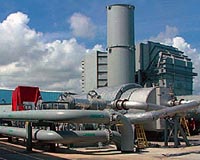 |
Beijing (UPI) Mar 7, 2011 China announced a series of green targets proposed in its latest five-year plan to be voted on this week. Chinese Premier Wen Jiabao, at the opening of Parliament's annual session Saturday said China aims to reduce energy consumption per unit of gross domestic product by 16 percent in the five years to 2015 on the basis of 2010, state-run news agency Xinhua reports. Specific goals under the draft 12th Five-Year Plan (2011-15) for the world's top emitter of greenhouse gases include cutting carbon dioxide emissions by 17 percent, per unit of GDP from 2010 levels and slashing major pollutant emissions by 8 to 10 percent, Zhang Guobao, former head of the National Energy Administration told reporters. "These are effective measures in response to climate change," Zhang said. He said responsibility for meeting the targets would be divided among regions and related businesses, making the targets "mandatory and binding." The targets are part of a wider plan to reduce carbon intensity by 40 to 45 percent by 2020. China also aims to generate 70 million kilowatts of wind power capacity and 5 million kilowatts of solar power capacity under the draft plan. Zhang said China, which relies on coal for 70 percent of its energy needs, aims to limit energy consumption in 2015 to 4 billion metric tons of coal or its equivalent in other fuels. That represents an annual increase of 4.24 percent from 2010's total of just more than 3.2 billion tons. As part of the five-year plan, China will construct oil and natural gas pipelines totaling about 99,419 miles in the next five years, including a gas pipeline to central Asia and oil pipelines to Kazakhstan and Myanmar. Zhang told Xinhua that the country must carry out an "arduous" task to protect its energy security. "Oil security is the most important part of achieving energy security," he said. "Preparations for alternative energies should be made as soon as possible." Imports account for nearly two-thirds of China's oil, global energy consulting firm Wood Mackenzie says, and the country is expected to surpass the United States for its share of percentage of imported oil in 2011. Prior to its economic boom and rise to the world's second largest economy, China was a net exporter of oil, as recently as 1992. Fatih Birol, chief economist of the International Energy Agency, told The New York Times that the goals in China's new five-year plan are consistent with IEA's "new policies" plan for climate change, saying that the draft plan was a middle course that represents an improvement from the country's current policies. However, he said the goals are still not sufficient to meet the what the agency says is needed to prevent world temperatures from rising by more than 2 degrees Celsius, an increase widely considered by scientists that would lead to considerable environmental changes.
Share This Article With Planet Earth
Related Links Powering The World in the 21st Century at Energy-Daily.com
 Supercritical Carbon Dioxide Brayton Cycle Turbines Promise Giant Leap
Supercritical Carbon Dioxide Brayton Cycle Turbines Promise Giant LeapAlbuquerque NM (SPX) Mar 07, 2011 Sandia National Laboratories researchers are moving into the demonstration phase of a novel gas turbine system for power generation, with the promise that thermal-to-electric conversion efficiency will be increased to as much as 50 percent - an improvement of 50 percent for nuclear power stations equipped with steam turbines, or a 40 percent improvement for simple gas turbines. The system is als ... read more |
|
| The content herein, unless otherwise known to be public domain, are Copyright 1995-2010 - SpaceDaily. AFP and UPI Wire Stories are copyright Agence France-Presse and United Press International. ESA Portal Reports are copyright European Space Agency. All NASA sourced material is public domain. Additional copyrights may apply in whole or part to other bona fide parties. Advertising does not imply endorsement,agreement or approval of any opinions, statements or information provided by SpaceDaily on any Web page published or hosted by SpaceDaily. Privacy Statement |